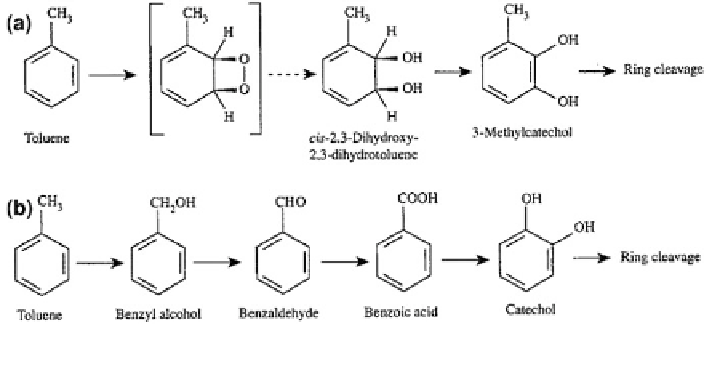Geoscience Reference
In-Depth Information
Fig. 16.31 Aerobic toluene degradation pathway by a aromatic ring attack by dioxygenation,
and b side-chain attack by stepwise oxidation (Smith
1990
)
are degraded in aerobic environments by a wide variety of bacteria and fungi that
contain the genetic capability to incorporate molecular oxygen into the hydro-
carbon system. Both prokaryotic and eukaryotic microorganisms have the enzy-
matic potential to oxidize aromatic hydrocarbons. While bacteria utilize the
compounds as a sole source of carbon and energy, fungi cometabolize aromatic
hydrocarbons to hydroxylated products. The first step in fungal metabolism is the
formation of an epoxide; bacteria initiate the oxidation of unsubstituted aromatic
compounds by incorporating both atoms of molecular oxygen into the aromatic
ring, to form a cis-dihydrodiol and by further oxidation that leads to catechol
formation (Gibson and Subramanian
1984
; Reineke
2001
).
Aerobic conditions for biologically mediated toluene degradation favor an
aromatic ring attack by dioxygenation, and a side-chain attack by stepwise oxi-
dation (Smith
1990
). These degradation pathways are illustrated in Fig.
16.31
.In
these cases, the presence of an alkyl substituent group on the benzene ring allows
microorganisms an additional site of attack; oxidation of this chain results in the
formation of benzyl alcohols, benzaldehydes, and alkylbenzoic acids. The oxi-
dation of straight-chain alkanes proceeds by oxidation of the terminal ethyl group,
a process mediated by a class of enzymes called oxygenases. The most degradable
n-alkanes are the C
10
-C
18
compounds (Fig.
16.32
). The intermediate products
include alcohols, aldehydes, and carboxylic acids (Bouwer and Zehnder
1993
).
Aerobic degradation reactions require available moisture, nitrogen, and phos-
phorus in addition to molecular oxygen; nutrient availability is the limiting factor
for biodegradation when oxygen and moisture are plentiful.
Anaerobic conditions often develop in hydrocarbon-contaminated subsurface
sites due to rapid aerobic biodegradation rates and limited supply of oxygen. In the
absence of O
2
, oxidized forms or natural organic materials, such as humic sub-
stances, are used by microorganisms as electron acceptors. Because many sites
polluted
by
petroleum
hydrocarbons
are
depleted
of
oxygen,
alternative

